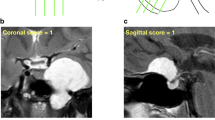Abstract
To review the clinical manifestations and outcomes of those with sellar meningiomas treated surgically at Mayo Clinic between 1975 and 2003. This is a retrospective chart and pathology review of 17 patients with a diagnosis of purely or largely intrasellar meningiomas treated surgically at our institution. Data in regards to presentation, endocrine hormonal status, surgical approach, pathology findings, outcome and adjunctive treatment were abstracted from the medical records. The majority of patients present with visual disturbances. All 17 tumors were WHO grade I. Surgical cure was achieved in 53 % after initial surgery. Postsurgical hypopituitarism occurred with high frequency. A substantial proportion of patients required subsequent surgical intervention or adjunctive treatment with external beam radiation. Sellar meningiomas are technically challenging and carry a high risk for visual disturbance and pituitary hormonal abnormalities. Many patients experience persistent disease requiring further intervention. These patients require long-term follow-up for evaluation of recurrence or development of new pituitary hormonal insufficiencies.


Similar content being viewed by others
References
FitzPatrick M et al. (1999) Imaging of sellar and parasellar pathology. Radiol Clin North Am 37(1):101–121
Huang BY, Castillo M (2005) Nonadenomatous tumors of the pituitary and sella turcica. Top Magn Reson Imaging 16(4):289–299
Famini P, Maya MM, Melmed S (2011) Pituitary magnetic resonance imaging for sellar and parasellar masses: ten-year experience in 2598 patients. J Clin Endocrinol Metab 96(6):1633–1641
Scheithauer BW et al (1987) Pituitary adenomas of the multiple endocrine neoplasia type I syndrome. Semin Diagn Pathol 4(3):205–211
Campbell BA et al (2009) Meningiomas in 2009: controversies and future challenges. Am J Clin Oncol 32(1):73–85
Goldsher D et al (1990) Dural “tail” associated with meningiomas on Gd-DTPA-enhanced MR images: characteristics, differential diagnostic value, and possible implications for treatment. Radiology 176(2):447–450
Tokumaru A et al (1990) Prominent meningeal enhancement adjacent to meningioma on Gd-DTPA-enhanced MR images: histopathologic correlation. Radiology 175(2):431–433
Wilms G et al (1989) Thickening of dura surrounding meningiomas: MR features. J Comput Assist Tomogr 13(5):763–768
Satoh H et al (1996) Intrasellar meningioma: characteristic imaging findings. Neuroradiology 38(4):328–329
Taylor SL et al (1992) Magnetic resonance imaging of tuberculum sellae meningiomas: preventing preoperative misdiagnosis as pituitary macroadenoma. Neurosurgery 31(4):621–627; discussion 627
Bassiouni H, Asgari S, Stolke D (2006) Tuberculum sellae meningiomas: functional outcome in a consecutive series treated microsurgically. Surg Neurol 66(1): 37–44; discussion 44–45
Al-Mefty O et al (1985) Microsurgical removal of suprasellar meningiomas. Neurosurgery 16(3):364–372
Kim TW et al (2008) Prognostic factors of postoperative visual outcomes in tuberculum sellae meningioma. Br J Neurosurg 22(2):231–234
Sheehan MT et al (1999) Preliminary comparison of the endoscopic transnasal vs the sublabial transseptal approach for clinically nonfunctioning pituitary macroadenomas. Mayo Clin Proc 74(7):661–670
Nozaki K et al (1997) Intrasellar meningioma: case report and review of the literature. Surg Neurol 47(5):447–452; discussion 452–454
Ciric I, Rosenblatt S (2001) Suprasellar meningiomas. Neurosurgery 49(6):1372–1377
Goel A, Muzumdar D, Desai KI (2002) Tuberculum sellae meningioma: a report on management on the basis of a surgical experience with 70 patients. Neurosurgery 51(6):1358–1363; discussion 1363–4
de Divitiis E et al. (2008) Tuberculum sellae meningiomas: high route or low route? A series of 51 consecutive cases. Neurosurgery 62(3):556–563; discussion 556–563
de Divitiis E et al. (2007) Extended endoscopic endonasal transsphenoidal approach for the removal of suprasellar tumors: part 2. Neurosurgery 60(1):46–58; discussion 58–59
Zevgaridis D et al (2001) Meningiomas of the sellar region presenting with visual impairment: impact of various prognostic factors on surgical outcome in 62 patients. Acta Neurochir 143(5):471–476
Barbaro NM et al (1987) Radiation therapy in the treatment of partially resected meningiomas. Neurosurgery 20(4):525–528
Goldsmith BJ et al (1994) Postoperative irradiation for subtotally resected meningiomas. A retrospective analysis of 140 patients treated from 1967 to 1990. J Neurosurg 80(2):195–201
Goyal LK et al (2000) Local control and overall survival in atypical meningioma: a retrospective study. Int J Radiat Oncol Biol Phys 46(1):57–61
Hug EB et al (2000) Management of atypical and malignant meningiomas: role of high-dose, 3D-conformal radiation therapy. J Neurooncol 48(2):151–160
Jaaskelainen J, Haltia M, Servo A (1986) Atypical and anaplastic meningiomas: radiology, surgery, radiotherapy, and outcome. Surg Neurol 25(3):233–242
Kokubo M et al (2000) Efficacy of conventional radiotherapy for recurrent meningioma. J Neurooncol 48(1):51–55
Lee JY et al (2002) Stereotactic radiosurgery providing long-term tumor control of cavernous sinus meningiomas. J Neurosurg 97(1):65–72
Stafford SL et al (2001) Meningioma radiosurgery: tumor control, outcomes, and complications among 190 consecutive patients. Neurosurgery 49(5):1029–1037; discussion 1037–1038
Acknowledgment
We would like to dedicate this paper in memory of Dr. Bernd Scheithauer, who actively participated in preparation of this manuscript. We are grateful for his mentorship, collegiality, expertise, and his human spirit of generosity.
Conflict of interest
The authors declare that they have no conflict of interest.
Author information
Authors and Affiliations
Corresponding author
Additional information
Bernd W. Scheithauer: Deceased.
Rights and permissions
About this article
Cite this article
Sathananthan, M., Sathananthan, A., Scheithauer, B.W. et al. Sellar meningiomas: an endocrinologic perspective. Pituitary 16, 182–188 (2013). https://doi.org/10.1007/s11102-012-0399-3
Published:
Issue Date:
DOI: https://doi.org/10.1007/s11102-012-0399-3



